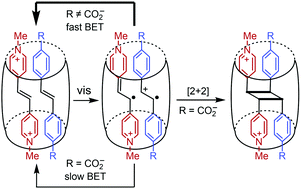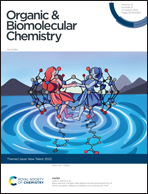Back electron transfer rates determine the photoreactivity of donor–acceptor stilbene complexes in a macrocyclic host†
Abstract
Host–guest 2 : 1 complexation of photoreactive alkene guests improves the selectivity of [2 + 2] photodimerizations by templating alkene orientation prior to irradiation. Host–guest chemistry can also provide 1 : 1 : 1 complexes through the inclusion of electronically complementary donor and acceptor guests, but the photoreactivity of such complexes has not been investigated. We imagined that such complexes could enable selective cross-[2 + 2] photocycloadditions between donor and acceptor stilbenes. In pursuit of this strategy, we investigated a series of stilbenes and found 1 : 1 : 1 complexes with cucurbit[8]uril that exhibited charge-transfer (CT) absorption bands in the visible and near-IR regions. Irradiation of the CT band of an azastilbene, 4,4′-stilbenedicarboxylate, and cucurbit[8]uril ternary complex led to a selective cross-[2 + 2] photocycloaddition, while other substrate pairs exhibited no productive chemistry upon CT excitation. Using transient absorption spectroscopy, we were able to understand the variable photoreactivity of different stilbene donor–acceptor complexes. We found that back electron transfer following CT excitation of the photoreactive complex is positioned deep in the Marcus inverted region due to electrostatic stabilization of the ground state, allowing [2 + 2] to effectively compete with this relaxation pathway. Control reactions revealed that the cucurbit[8]uril host not only serves to template the reaction from the ground state, but also protects the long-lived radical ions formed by CT from side reactions. This protective role of the host suggests that donor–acceptor host–guest ternary complexes could be used to improve existing CT-initiated photochemistry or access new reactivity.

- This article is part of the themed collection: New Talent


 Please wait while we load your content...
Please wait while we load your content...